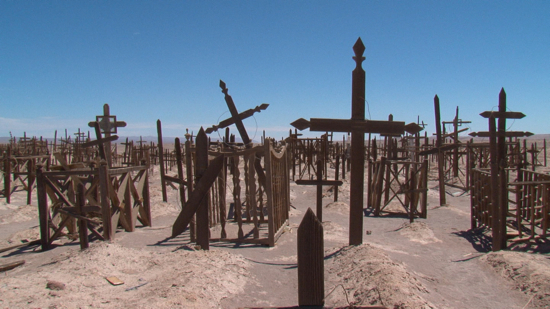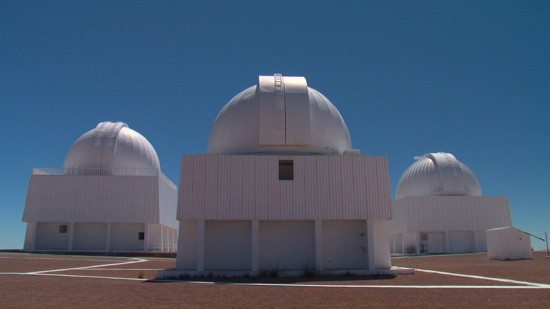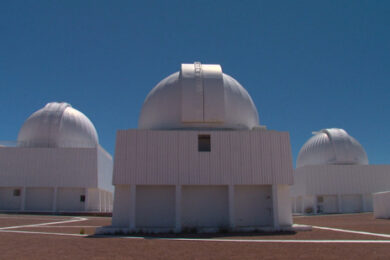The 20th century began with visions of utopia and ended in spectres of nostalgia. A cinematic image of nostalgia is a double exposure, or a superimposition of two images: home and abroad, past and present, dream and everyday life. The moment we try to force it into a single image, it shatters the frame or burns the surface. Patricio Guzman’s documentary Nostalgia For The Light is an unsettling and humbling account of this tension, using the prism of the Atacama Desert in Chile to embark on a trip through geography, astronomy, memory and the hidden horrors of the last century.
The Atacama is situated more than 10,000 feet above sea level and is one of the driest places on Earth. Viewed from space, it is a brown spot on the planet. Some of the area’s most arid parts have never once recorded rainfall and the lack of moisture ensures everything is preserved. Pre-Columbian rock drawings from over 2000 years ago are visible in the desert, much to the interest of the Chilean public. Guzmán calls the Atacama a "gateway to the past". Scores of archaeologists converge to study the ancient remains preserved in the unforgiving climate, astronomers gather atop its mountains – the translucency enabling them to shed light on the mysteries of space – and surviving relatives of the disappeared under Pinochet’s military coup dredge through the endless sands for the remains of their loved ones. Accordingly, the desert provides the vast territory for parallel searches for the cosmic and the human, the primeval and the present.
The fact that Guzmán manages to effortlessly collate these colossal subjects and chisel them into a cohesive film is perhaps not surprising considering his pedigree. The director initially came to prominence as a protégé of Chris Marker, who donated the raw stock necessary to film The Battle Of Chile, the four and half hour trilogy focusing on Salvador Allende’s final year in government prior to Pinochet’s coup d’état on September 11, 1973. This remarkable documentary established Guzmán as a significant, singular voice within the new breed of politically charged Latin American cinema which began to define, question and ultimately challenge the historical moment through the possibilities of film, in the face of extreme cultural amnesia.
Nostalgia For The Light‘s mélange of spiritual and scientific pursuits casts Guzmán into the realm of Werner Herzog, who explored similar intersections in his Encounters At The End Of The World (2007). However, Herzog’s approach is positively parochial in the face of Guzman’s far-reaching reportage, the latter’s gaze extending far into moral and metaphysical territories, most vividly illuminated by the stories of the women spending the last 28 years combing the desert merely to locate the decomposed bodies of the disappeared. This dialectic between earthbound realists and astronomers is effortlessly united under a blanket of humanism and tentative optimism. The former are wounded survivors, in search of meaning and closure for the present; the latter idealists in search of similar meaning through an ancient, forgotten past.
Guzmán interviews his subjects in a tentative fashion, never overtly probing yet still managing to evoke trust and candour. Miguel, a former desert prison camp inmate and survivor of Pinochet’s regime, manages to detail the five concentration camps he was detained in with uncanny accuracy, drawing pictures which relate the horrific work regimes and torture devices, all to discomfort of the ruling party. His wife suffers from Alzheimer’s. While he remembers, she forgets, neatly symbolising Chile’s conflicted relationship with the past.

In accordance with the film’s grand scope, Guzmán’s visuals suitably dissolve the traditional dimensions of perception. There are quick cuts between differing sets of people searching for calcium in the Atacama: one group under blood-stained rock, another in the stars. The desert’s texture and colour intermingle with that of a 10,000 year old skeleton; marbles from the filmmaker’s childhood correspond with the shape and design of celestial bodies. This blurring of time is taken to extremes by Gaspar, an astronomer working at the Atacama observatory, who believes that the present only exists as "a state of consciousness", or a living memory of the past. This leads to a poignant meeting between Gaspar and Violeta, one of the women in search of her lost relatives. Their tangential journeys intersect as they marvel at the firmament, with Gaspar remarking that the moon has bore witness to human acts for millions of years and knows where their missing relatives are.
Such moments of poetic compassion punctuate the rhythmic heart of Nostalgia For The Light. Guzmán elicits the paradox of a culture in which prehistoric rock drawings attract national interest yet genocide in living memory is largely forgotten. The astrology of memory and the topography of forgetting unite in his evocation of the Atacama Desert, becoming a legacy for the disappeared and a poetic elegy on utopia, in the face of overwhelming and ultimately painful realities.
Nostalgia For The Light is released theatrically nationwide this Friday July 13; a full list of screenings can be found at the New Wave Films website. It also enjoys an extended run as part of the BFI Southbank season Patricio Guzmán: The Power Of Memory.



